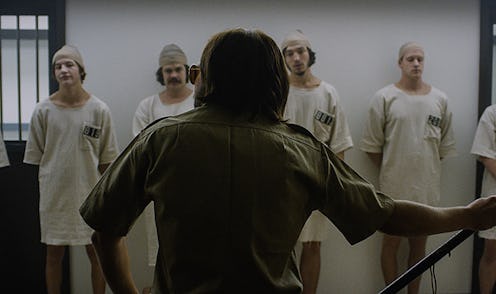Entertainment
'Stanford Prison Experiment' Was Saved By A Woman

Watching Kyle Patrick Alvarez's visceral drama The Stanford Prison Experiment made me realize what basic human luxuries I take for granted every single day: Privacy, sunlight, clothing, sleep, medication, access to a doctor, and even the ability to smile. In the 2015 retelling of the iconic 1971 experiment, Alvarez uses a narrative lense to take us deep inside the confides of the summer experiment featuring 24 young boys who were paid 15 dollars a day to play dress up. It's been more than 40 years since the prison/guard simulation commenced, and students are still learning about the powerful results of 71, Dr. Philip Zimbardo's study in Psych 101 courses to this day. "The film wasn't made with any didactic or progressive aim, but I do hope it insights empathy and understanding in power struggles work," says director Alvarez, whose previous credits include Easier With Practice and C.O.G.
"I think considering [power dynamics] allows us to be more openminded when people do bad things in certain situations. Not to say it's OK to do bad things, but as Phil says, 'It's not one bad apple, it's the barrel that's bad.' It's the system itself. It's the situation," he says. "And I think it's important to look at that and find a balance where you hold people accountable for their actions, but are also able to empathize with what brought them there. It's an important part of humanity," the 32-year-old director says.
For those who might need a refresher, Psychologist Dr. Philip Zimbardo (played by Billy Crudup) crafted the study as an investigation into the psychological effects of incarceration, authority, control over individuals, and of course, power. With the help of his professional colleagues and an ex convict who spent time in San Quentin — let's call this Zimbardo's attempt at legitimizing the experiment — he employed 24 young men as his subjects. He built a mock prison in the basement of Stanford University, and assigned the men roles as either prisoners or guards.
"I read the script and thought, 'All of this can't be true!'" says Alvarez, who, after reading up on the details of the experiment, couldn't believe how closely the script followed the real life experiment. "I always said the most successful version of this movie is one that leads people to the Wikipedia page. I wanted to be really careful that when we did embellish things, there was a really specific reason for it, and that we weren't hurting the core basis of the experiment or the nature of what really happened."
The simulation was intended to last two weeks, but as it became clear the mental state of the prisoners was becoming too fragile, and in some cases the malicious intent of the guards was becoming increasingly intense, the project was called off after a mere 6 days. Zimbardo himself became too invested in the experiment, perhaps compromising the mental state of his subjects," says Alvarez
The young men were all succumbing to their roles much more deeply, and quickly, than Zimbardo had anticipated. But it took an outsider's perspective — a young female named Christina (Olivia Thirlby) who Dr. Zimbardo would go on to marry — to force Zimbardo to shut the experiment down.
"One of the things I love about the story is, and this is arguably a feminist case here, is that all the men went insane, but the one woman was like: 'What the hell are you doing?'" says the director. "Even the priest that showed up got lost in it. Olivia's character isn't in the film a lot, but her presence means a lot. There's something to be said that it did take a woman to end it, to really say, 'This has to stop.'"
Other than pure, edge-of-your-seat entertainment value, the film has a lot to offer. "We wanted to encourage people to learn about the experiment, and discuss what the experiment really meant as opposed to telling them," Alvarez explains. "You wonder, 'How would I have acted in this situation?' It makes you think, 'Maybe I would have behaved this way, I dunno. I've never been locked in a room without sun or sleep for five days, so maybe I would have lost my mind.'"
See The Stanford Prison Experiment in theaters Friday, July 17.
Images: IFC